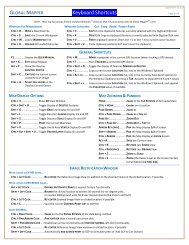Map GPS Coordinates - GPS Map Coordinates ... - Global Mapper
Map GPS Coordinates - GPS Map Coordinates ... - Global Mapper
Map GPS Coordinates - GPS Map Coordinates ... - Global Mapper
Create successful ePaper yourself
Turn your PDF publications into a flip-book with our unique Google optimized e-Paper software.
<x-pixel location>,<y-pixel location>,<x-ground location>,<y-ground location>,<point<br />
name (optional)>,<point error in pixels (optional)><br />
There are also options on the File menu for loading control points and projection information from an<br />
OziExplorer .map, Compe<strong>GPS</strong> .imp, and Touratech TTQV .cal files as well as saving your control point<br />
information to world (TFW, JGW, etc.) files.<br />
Options Menu<br />
<strong>Global</strong> <strong>Map</strong>per User's Manual<br />
The Options menu allows you to setup various options related to the rectification process, as described below:<br />
• Rectification Method - the Rectification Method submenu allows you to select which rectification<br />
method (hence the name) to apply to the entered control points. Different methods are available based<br />
on how many control points have been entered. The various methods are as follows:<br />
♦ Automatic - the Automatic select automatically selects the "best" rectification method that is<br />
available based on the number of control points that have been entered. This is the default<br />
method and should rarely need to be changed.<br />
♦ Linear - the Linear rectification method is used when only two control points are entered.<br />
This is the simplest of the rectification methods and is equivalent to supplying a world file for<br />
the image. This method does not allow for any distortion or rotation in the image, but often<br />
works well if the correct projection is selected for the image.<br />
♦ Helmert - the Helmert, or similarity, rectification method requires at least two controls points<br />
to be entered. This rectification method is useful if you need to maintain the original shape of<br />
data after a transformation. This method will only be used if you explicitly select it from the<br />
list of rectification methods.<br />
♦ Affine - the Affine rectification method requires at least three controls points to be entered.<br />
This rectification method calculates a best fit to a simple equation of the control points<br />
entered. This method can account for some degree of rotation and distortion, but not with a<br />
high degree of accuracy. Because a best fit approximation is used, some of your ground<br />
points may move a little in order to minimize the error among all control points.<br />
♦ Polynomial - the Polynomial rectification method requires at least four control points to be<br />
entered. This rectification method calculates a best fit to a more complex polynomial equation<br />
described the transformation from pixel space to ground coordinate space. Because a best fit<br />
approximation is used, some of your ground points may move a little in order to minimize the<br />
error among all control points. If you have 6 or more control points, a second order (N=2)<br />
polynomial will be used to transform the points.<br />
♦ Triangulation - the Triangulation rectification method requires at least five control points to<br />
be entered. This rectification method performs a Delaunay triangulation for the control points<br />
and will exactly preserve the location of each entered control point. Occasionally the<br />
Triangulation method generates some odd results around the edges of the rectified image. If<br />
this happens, try to enter more control points around the edge of the image, or change your<br />
rectification method to Polynomial.<br />
• Resampling Method - the Resampling Method submenu allows you to select how the source image<br />
pixels will be resampled to create the rectified imagery. These setting simply control whether or not<br />
the Anti-Alias Pixels setting is turned on or off for rectified images. This can be changed later in the<br />
Overlay Control Center.<br />
♦ Nearest Neighbor - simply pick the closest pixel from the source image for each pixel in the<br />
rectified image. This can result in some blockiness. This is equivalent to having the<br />
Anti-Alias Pixels setting OFF.<br />
♦ Bilinear Interpolation - performs a weighted average of the four closest pixels in the source<br />
image to determine the color for a pixel in the rectified image. This is equivalent to having the<br />
<strong>Map</strong> <strong>GPS</strong> <strong>Coordinates</strong> - <strong>GPS</strong> <strong>Map</strong> <strong>Coordinates</strong> - <strong>GPS</strong><strong>Coordinates</strong> <strong>Map</strong> 105







